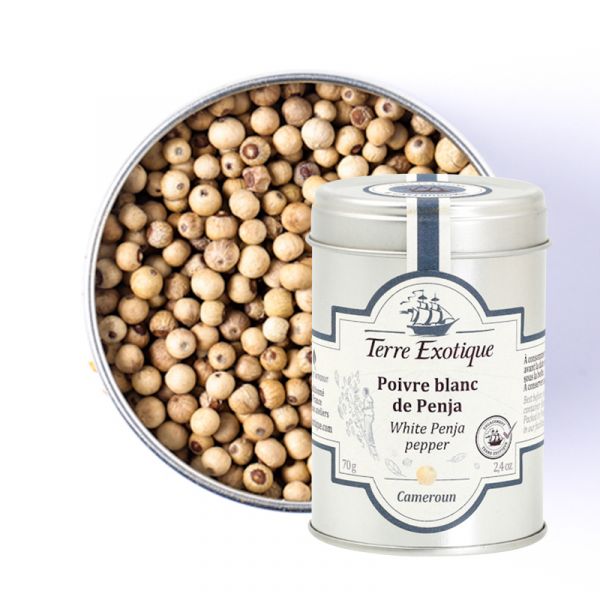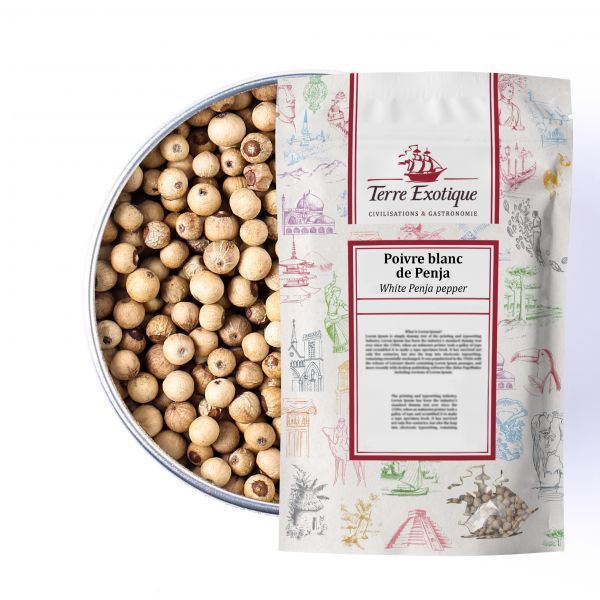





Where to use Penja white pepper
Explore the supple animal notes of this pepper
Penja white pepper is the star of peppers to have at hand for all your dishes, including the most sophisticated recipes. Perfect with foie gras, chocolate and even some cheeses, there are plenty of occasions to use this delicious pepper!
How to get the best from your Penja white pepper
Our recipe ideas for Penja white pepper:
· Roast asparagus in butter: crack the pepper and sprinkle over your asparagus;
· Marinated strawberries with Penja white pepper: add 6 Penja white peppercorns to your strawberries in a bowl, cover and leave to infuse overnight;
· Gooey chocolate cake with Penja white pepper: add two pinches of Penja white pepper in your cake mixture;
· Chocolate mousse: add 6 ground Penja white peppercorns to the melted chocolate;
· Pineapple, avocado & cucumber salad: sprinkle two pinches of Penja white pepper on your salad just before serving;
· Burrata with Penja pepper: sprinkle Penja white pepper on your burrata just before serving;
· Penja pizza: sprinkle two pinches of Penja white pepper in your pizza dough.
Cocktail 2014 # Matthias Giroud
Ingredients
14 Penja white peppercorns;
150ml fresh pineapple juice;
50ml mango juice;
50ml cranberry juice;
5ml orgeat almond cordial.
Method
Grind the Penja white pepper in a pestle and mortar and place in the cocktail shaker. Add the other ingredients then add 5 to 7 ice cubes to the shaker, and shake vigorously. Strain twice before pouring into glasses full of crushed ice.
Penja white pepper with animal and herby aromas
This white pepper has delicious supple and musky aromas due to the rich fertile soils of Cameroon. Its initial attack is hot and spicy, with longer animal and herby notes, especially when cracked rather than ground. It’s a complex but well-balanced pepper, the perfect companion for red meat or braised game.
Penja white pepper, a supple and complex treasure from Cameroon
Penja pepper is the fruit of a giant creeper: Piper nigrum. It grows up trees with rough, cracked bark which helps it grip on and climb up often as high as four metres. It is pollinated by the rain, which is frequent in the region of Moungo. The rich and fertile volcanic soils of Cameroon give Penja pepper its truly remarkable aromas and highly concentrated essential oils.
Penja white pepper is picked when fully ripe, washed, its pulp removed, then dried in the sun in the province of Moungo in Cameroon. All the production stages (harvest, retting, washing, drying, sorting) are entirely carried out by the expert hands of the local village women. Unlike other colours of pepper, white pepper is picked when fully ripe. It is then washed thoroughly and dried to remove its pericarp. This is what gives it its strong flavour.
Where does Penja pepper come from?
Terre Exotique and Penja pepper, the start of a long adventure
Erwann de Kerros first discovered the famous Penja pepper back in the 1990’s when working in Cameroon. He had just graduated and started work on a pepper plantation and was immediately over bowled by the outstanding Penja pepper. So much so, that the idea behind Terre Exotique was born in Penja. Erwann still returns to the Penja plantations in Cameroon every two years, to see how his much-loved pepper creepers are coming along.
Penja pepper was Terre Exotique’s very first product, before we widely extended our range of peppers and spices.
What is the difference between white, black and green pepper?
What is the difference between white, black and green pepper?
The difference is linked to the ripeness at which the peppercorns are harvested. Green pepper is a harvested before it is fully ripe which gives it its fresh lemony notes. Black pepper is picked just before it ripens then dried in the sun. Its aromas are spicy and full-bodied. White pepper is picked when fully ripe, it is then dried and its pericarp is removed.
Penja pepper - a well-kept traditional expertise
The first pepper plants were planted in Penja in the 1930’s by Mr. Decré, a banana plantation owner. The annual worldwide production is very small-scale, only amounting to 18 tonnes. The harvest remains traditional, always done by hand and none of the cleaning, drying or sorting methods have changed for generations. All this makes Penja pepper a rare and precious treasure in line with its amazing flavour.
Penja pepper is certainly a renowned gastronomic star worldwide! In 2014, it was the first product from the African continent to gain Protected Geographical Indication (PGI) status. A well-deserved recognition for this precious pepper.
| Allergen | Absence |
|---|---|
| Native country | CAMEROUN |
| Genus and botanical species | Piper nigrum |
| Ingredients | white Penja pepper PGI |
| Nutritional Info | VN Energie pour 100 g (energy for 100g) : 1239 kJ / 296 kcal VN Matière grasse (fat) : 2 g Dont acide gras saturés (of which saturated fat) : 1 g VN Glucides (carbohydrate) : 69 g Dont sucres (of which sugars) : 0.69 g VN Protéines (protein) : 10 g Vn Sel (salt) : 0.005 g |
| TRACES EVENTUELLES D'ALLERGÈNES | céleri, sésame, moutarde, fruits à coques. |
 Français
Français 





